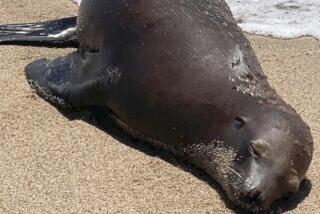Hunter Could Have Faced a Stiffer Charge
- Share via
A day after a Kern County man was charged with killing a California condor during a pig hunt on Tejon Ranch, a coordinator of the hunts on the sprawling property near Bakersfield said participants are specifically warned not to shoot at the endangered birds.
Employee Ron Gayer’s account is key because Britton Cole Lewis, 29, of Tehachapi, is charged with violating a federal law protecting migratory birds, rather than the U.S. Endangered Species Act. To file charges under the more stringent law, the Justice Department requires that a defendant know what species he was shooting.
The decision to prosecute Lewis under the lesser charge has angered environmentalists and those involved with a $35-million program aimed at rescuing the condor from extinction. Only 79 of the birds remain in the wild today.
It also has sparked a heated debate over the intent of the 1973 Endangered Species Act, one of the nation’s most powerful and disputed environmental laws.
Lewis is accused of shooting the condor known as AC-8, a matriarch of the government’s 23-year captive breeding program and one of the last California condors born in the wild. The incident occurred on or about Feb. 8 during a sanctioned pig hunt, federal prosecutors said.
Tejon Ranch attorney Dennis Mullens could not be reached for comment Wednesday.
But Gayer, who is a hunt coordinator for the ranch’s Game Management Program, said that participants in pig hunts are given pamphlets warning them not to shoot at large birds, including condors.
“It’s in the instructions we give them, in big, bold print,” Gayer said. “We have condors, as well as golden eagles and turkey vultures on the ranch. All of those raptors are protected--none of them are fair game to shoot at.”
The condor’s death has upset hunters like Gayer as well as environmentalists and state wildlife officials.
“This does a lot of damage to the legitimate hunting community,” said Sonke Mastrup, deputy director of the wildlife and inland fisheries division of the California Department of Fish and Game. “You don’t need knuckleheads going around shooting condors.”
Kurt Stiefler, Lewis’ attorney, declined to comment on the specifics of the case. As for the ranch’s efforts to educate hunters, he said: “Is it helpful to say there are protected birds? Probably. But I’m not sure how you’d determine whether you were shooting a protected bird or a non-protected bird.”
Violation of the 1973 Endangered Species Act carries a maximum penalty of one year in prison and a $100,000 fine, compared with a possible six-month prison term and a $15,000 fine under the charge Lewis faces.
Patty Pontello, a spokeswoman for the U.S. attorney’s office that brought the charges, said, “They charged him the way they could charge him in this case.”
The defendant could receive a harsher penalty if convicted on a separate charge that he knowingly brought into California the mounted head of a white-tailed deer he allegedly killed in Illinois using an invalid hunting permit. If convicted, Lewis faces the same penalty he would under the Endangered Species Act.
Meanwhile, the Center for Biological Diversity, an Arizona-based environmental lobbying group, is calling for the federal government to prosecute both Lewis and Tejon Ranch under the tougher law.
Peter Galvin, the group’s California director, said: “Tejon has numerous licensed hunters and guides on their property. The fact that this occurred under their watch and under their permit is an issue we feel should be addressed.”
More to Read
Sign up for Essential California
The most important California stories and recommendations in your inbox every morning.
You may occasionally receive promotional content from the Los Angeles Times.













